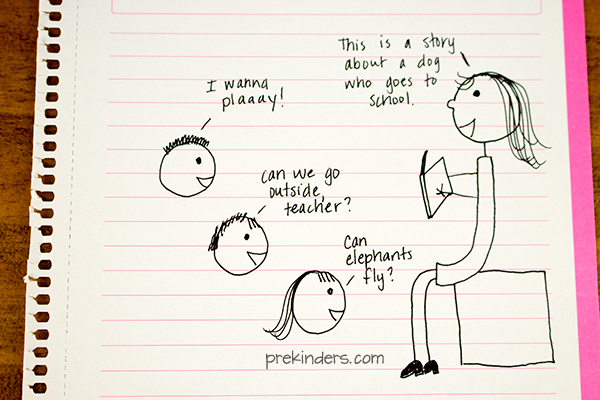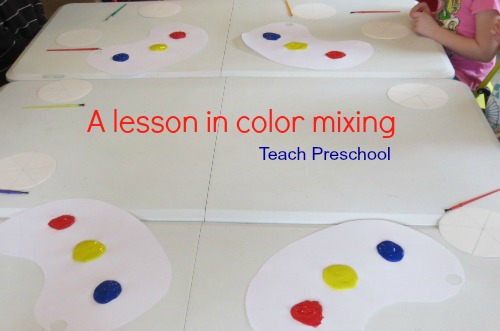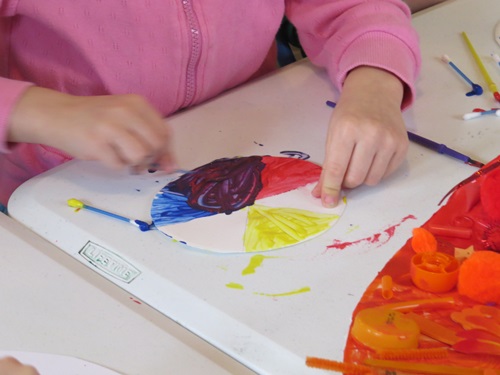There are 5 mistakes Pre-K teachers typically make in the first week of school. After years of trial and error, I now avoid doing these five things.
We preschool teachers typically do these things because it’s tradition, or it’s cute, or because Kindergarten and First Grade teachers do it (and we want to do it, too). This is all simply my opinion, and I know there are Pre-K teachers who will vehemently disagree with what I’m about to say, and that’s okay. I also know there are teachers who will find it refreshing to think, maybe I don’t have to do that school tradition any more.
As a bonus (or not), I’ve provided some terrible, very lame stick figure cartoons for your amusement (using the term amusement lightly). In other words, I couldn’t afford to hire a real artist. 


BY
1. Reading the wrong books the first week of school.
What do most early childhood teachers read the first day of school, the first week of school? It’s usually The Kissing Hand, or any book about going to school. It’s so cute, it’s so traditional to read this book the first day of school. Every teacher reads it, right?
I do not. The reason why? The book is too long for preschoolers’ very, very short attention spans (at least at the beginning of the year). I choose to read books that are short, fun, and very engaging. If there’s humor, even better. My favorite first day of school book is What Color is Your Underwear?, which is unfortunately out of print. (I would have thought my class could have single-handedly kept this book in print because I’ve bought so many copies.) The first week of school, we also read The Very Hungry Caterpillar, The Lady with the Alligator Purse, and the funny books by Jan Thomas.
Remember: Don’t think you have to read a book the first week of school just because it’s a book about school. Read books that are short, engaging, fun, and funny, and your first day will rock.
2. Going on a school tour.
Yes, I know what teachers who believe in school tours on the first day will say: It’s tradition! The kids love it! The kids need to tour their school so they know where everything is and who all the people are! Tours are cute because the kids find the gingerbread man/brown bear/etc. I used to do a school tour each year for those reasons. I stopped doing tours when I finally realized the only thing I succeeding in doing was making myself crazy and stressed.
Here’s the thing. Pre-K kids do not know how to walk in line or stay with the class or be quiet in the hall yet. The first day is stressful enough. Do you really want to do this?
Preschoolers don’t need to see the whole school the first day. Unlike older children, there won’t be a time when they will need to walk to the gym, library, or cafeteria by themselves. When they go anywhere in the school, they will be with you or other school personnel. They can see all of these school places and people when they need to go there the first time.
3. Teaching an apple theme the first week.
Do not teach any theme the first week — teach procedures instead! Pre-K kids don’t need to make apple prints with paint the first week, they need to learn procedures for using paint and cleaning it up. Forget the apple science experiments, instead teach them how to live in a classroom with lots of other children. My first week lessons are all about how to line up, how to sit at circle time, how to close the marker caps, how to use glue, how to use scissors, how to clean up the blocks, how to treat the books. If you spend this valuable time teaching apples instead of procedures, you will live to regret it.
4. Forgetting where they come from.
Remember that these children have only been alive for 4 years. Really think about that — only four. While some children may have come from a preschool or childcare setting, for many children, this will be their first ever experience in school.
You have to teach them everything, even the most basic things, like clicking marker caps, walking in line, staying in their seat at lunch. You will have to teach them how to use manners, show respect, keep their hands to themselves. This will be the first day that many will be in a structured environment. The first day they don’t get to watch TV whenever they choose. The first time they have to line up on the playground when the teacher calls them inside. The first time they don’t drink out of a sippy cup. The first time they hold a pair of scissors.
You will have to teach them to flush the toilet, wash their hands, and what not to do in a bathroom urinal. There’s so much for them to learn this first week of school! Remember they will not come to you knowing these things because this is their first time in school.
5. Giving them too much too soon.
For the first week of school, limit the amount of materials and toys that are available to the kids. Too many will overwhelm children. Introduce most items to the class before placing it out for them to use. For example, I do not have dry erase boards and markers available until I show the class how to use them. Stick with basic materials and limit what you have either by putting some materials away in a closet or hiding them. Many teachers don’t have the extra storage space the put some things away, and in that case, you can turn some of your shelves around facing the wall, or cover some shelves with fabric or plastic table cloths, or wrap some items like a gift to be opened later. Most preschool classrooms are the ultimate playroom because we have so much available to the kids, but at the beginning, that can be overwhelming to children who are new to a school setting.
While I know some teachers won’t agree with me (and I may have stepped on some toes), these are five things I’ve learned to avoid the first week of school. Avoiding these help me have a less stressful start to the school year.

























